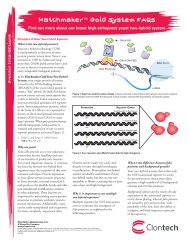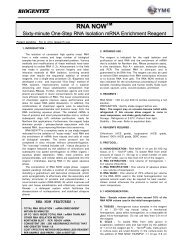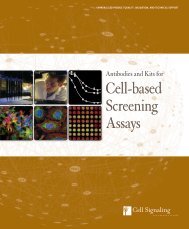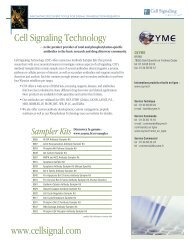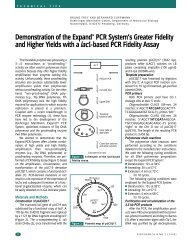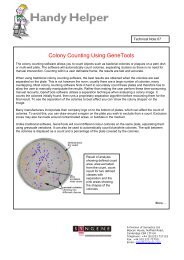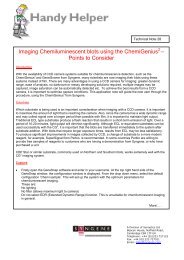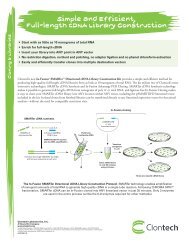DNA polymerase fidelity and the polymerase chain reaction. - Ozyme
DNA polymerase fidelity and the polymerase chain reaction. - Ozyme
DNA polymerase fidelity and the polymerase chain reaction. - Ozyme
Create successful ePaper yourself
Turn your PDF publications into a flip-book with our unique Google optimized e-Paper software.
Downloaded from genome.cshlp.org on October 11, 2011 - Published by Cold Spring Harbor Laboratory Press<br />
<strong>DNA</strong> <strong>polymerase</strong> <strong>fidelity</strong> <strong>and</strong> <strong>the</strong> <strong>polymerase</strong> <strong>chain</strong> <strong>reaction</strong>.<br />
K A Eckert <strong>and</strong> T A Kunkel<br />
Genome Res. 1991 1: 17-24<br />
Access <strong>the</strong> most recent version at doi:10.1101/gr.1.1.17<br />
References<br />
Email alerting<br />
service<br />
This article cites 45 articles, 32 of which can be accessed free at:<br />
http://genome.cshlp.org/content/1/1/17.refs.html<br />
Receive free email alerts when new articles cite this article - sign up in <strong>the</strong> box at <strong>the</strong><br />
top right corner of <strong>the</strong> article or click here<br />
To subscribe to Genome Research go to:<br />
http://genome.cshlp.org/subscriptions<br />
Copyright © Cold Spring Harbor Laboratory Press
Downloaded from genome.cshlp.org on October 11, 2011 - Published by Cold Spring Harbor Laboratory Press<br />
<strong>DNA</strong> Polymerase Fidelity<br />
<strong>and</strong> <strong>the</strong> Polymerase Chain<br />
Reaction<br />
Kristin A. Eckert <strong>and</strong> Thomas A. Kunkel<br />
Laboratory of Molecular Genetics, National Institute of Environmental Health<br />
Sciences, Research Triangle Park, NC 27709<br />
The distinctive ability of <strong>the</strong><br />
<strong>polymerase</strong> <strong>chain</strong> <strong>reaction</strong> (PCR) to<br />
produce a substantial quantity of <strong>DNA</strong><br />
from an initially small amount of genetic<br />
material is revolutionizing<br />
molecular biology. The variety of highly<br />
successful applications of PCR technology<br />
<strong>and</strong> <strong>the</strong> ease with which PCR<br />
can be performed should not be<br />
misinterpreted as evidence that <strong>the</strong><br />
PCR is a simple process. In fact, quite<br />
<strong>the</strong> opposite is true. A single cycle of<br />
<strong>DNA</strong> polymerization is a complex process<br />
requiring <strong>the</strong> precise interaction of<br />
several components. The repetitive<br />
cycles characteristic of PCR provide an<br />
additional layer of complexity to <strong>the</strong><br />
technique. The final PCR product cannot<br />
be considered a unique entity, as<br />
even a discrete <strong>DNA</strong> b<strong>and</strong> on an<br />
agarose gel may contain a variety of<br />
<strong>DNA</strong> molecules differing from <strong>the</strong><br />
original genetic information by one or<br />
more nucleotides.<br />
How serious a concern is <strong>the</strong> <strong>fidelity</strong><br />
of PCR The answer depends on <strong>the</strong><br />
precise nature of <strong>the</strong> application. In<br />
many instances, for example, direct<br />
characterization of <strong>the</strong> amplified population<br />
by <strong>DNA</strong> sequence analysis or<br />
nucleic acid hybridization, r<strong>and</strong>om errors<br />
in nucleotide sequence that may<br />
be produced during PCR are of little<br />
concern. However, some PCR applications<br />
involve <strong>the</strong> characterization of<br />
individual <strong>DNA</strong> molecules or rare<br />
molecules present in a heterogeneous<br />
population. Examples include <strong>the</strong><br />
study of allelic polymorphism in individual<br />
mRNA transcripts O,2) <strong>and</strong> <strong>the</strong><br />
characterization of <strong>the</strong> allelic states of<br />
single sperm cells (3) or single <strong>DNA</strong><br />
molecules. (4,s) In <strong>the</strong>se circumstances,<br />
<strong>the</strong> <strong>fidelity</strong> (error rate per nucleotide)<br />
of PCR is an important consideration,<br />
because errors generated during<br />
amplification may interfere with <strong>the</strong><br />
interpretation of data.<br />
During enzymatic <strong>DNA</strong> amplification,<br />
<strong>the</strong> majority of changes in nucleotide<br />
sequence can be attributed to errors<br />
made by <strong>the</strong> <strong>DNA</strong> <strong>polymerase</strong>.<br />
While PCR is a recent development in<br />
<strong>the</strong> field of molecular biology, <strong>the</strong> <strong>fidelity</strong><br />
of <strong>DNA</strong> <strong>polymerase</strong>s has been<br />
studied biochemically for almost 30<br />
years. In this review, we will attempt to<br />
relate our current underst<strong>and</strong>ing of <strong>the</strong><br />
mechanisms of <strong>polymerase</strong> <strong>fidelity</strong> in<br />
vitro to <strong>the</strong> accuracy of enzymatic<br />
<strong>DNA</strong> amplification. We begin by describing<br />
steps in <strong>polymerase</strong> error discrimination<br />
<strong>and</strong> variables important<br />
for determining <strong>fidelity</strong>. The error rates<br />
of several <strong>DNA</strong> <strong>polymerase</strong>s that have<br />
been used for PCR will be described,<br />
first as determined in model "onecycle"<br />
<strong>fidelity</strong> assays <strong>and</strong> <strong>the</strong>n during<br />
actual PCR. Our intent is to focus on<br />
<strong>the</strong> variables known to influence <strong>the</strong><br />
<strong>fidelity</strong> of <strong>DNA</strong> syn<strong>the</strong>sis in vitro that<br />
can be controlled experimentally.<br />
ERROR ACCUMULATION<br />
PCR<br />
DURING<br />
Error rates in PCR vary according to<br />
<strong>the</strong> precise <strong>DNA</strong> sequence <strong>and</strong> <strong>the</strong> in<br />
vitro conditions of <strong>DNA</strong> syn<strong>the</strong>sis.<br />
Several laboratories have estimated <strong>the</strong><br />
error frequency (mutations per<br />
nucleotide per cycle) during PCR<br />
catalyzed by <strong>the</strong> <strong>the</strong>rmostable Thermus<br />
aquaticus (Taq) <strong>DNA</strong> <strong>polymerase</strong> by<br />
cloning individual <strong>DNA</strong> molecules<br />
from <strong>the</strong> amplified population <strong>and</strong><br />
determining <strong>the</strong> number of <strong>DNA</strong> sequence<br />
changes. (6-12) As seen from <strong>the</strong><br />
data in Table 1, observed error frequencies<br />
during PCR vary more than 10-<br />
fold, from -2 x 10 -4 to
Downloaded from genome.cshlp.org on October 11, 2011 - Published by Cold Spring Harbor Laboratory Press<br />
per cycle are an important consideration<br />
for any PCR application that begins<br />
with a small amount of starting<br />
material (i.e., less than a total of<br />
10,000 nucleotides of target <strong>DNA</strong>) or<br />
that focuses on individual <strong>DNA</strong><br />
molecules present in <strong>the</strong> final PCR<br />
population.<br />
The proportion of <strong>DNA</strong> molecules<br />
that contain sequence changes is a<br />
function of <strong>the</strong> error rate per nucleotide<br />
per cycle, <strong>the</strong> number of amplification<br />
cycles, <strong>and</strong> <strong>the</strong> starting population<br />
size.t13,14) The population of<br />
altered <strong>DNA</strong> molecules arises during<br />
PCR from two sources: (1) new errors<br />
at each cycle <strong>and</strong> (2) <strong>the</strong> amplification<br />
of <strong>DNA</strong> molecules containing errors<br />
from previous cycles. On average, <strong>the</strong><br />
same number of <strong>DNA</strong> sequence<br />
changes in <strong>the</strong> final population results<br />
from <strong>polymerase</strong> errors during <strong>the</strong> last<br />
amplification cycle as result from <strong>the</strong><br />
amplification of errors that occurred<br />
during previous cycles. The formula f =<br />
np/2 describes <strong>the</strong> average mutation<br />
frequency (f) for PCR amplification as a<br />
function of <strong>the</strong> <strong>polymerase</strong> error rate<br />
per nucleotide per cycle (p) <strong>and</strong> <strong>the</strong><br />
number of cycles (n), assuming that p<br />
is constant at each cycle (for more<br />
detailed ma<strong>the</strong>matical analyses, see<br />
refs. 13 <strong>and</strong> 14). Theoretically, <strong>the</strong> frequency<br />
of <strong>DNA</strong> sequence changes can<br />
be controlled by altering <strong>the</strong> number<br />
of cycles (n) <strong>and</strong>/or <strong>the</strong> <strong>polymerase</strong> error<br />
rate per nucleotide (p) (see Table 6<br />
in ref. 13). For example, as <strong>the</strong> number<br />
of cycles increases, <strong>the</strong> error frequency<br />
is expected to increase. Keeping p constant<br />
at one error per 10,000<br />
nucleotides per cycle, <strong>the</strong> error frequency<br />
when n = 20 cycles is one<br />
change per 1000 nucleotides <strong>and</strong> increases<br />
to one change per 400<br />
nucleotides after 50 amplification<br />
cycles. Alternatively, <strong>the</strong> final error frequency<br />
can be varied by changing p,<br />
<strong>the</strong> <strong>polymerase</strong> error rate. Keeping a<br />
constant cycle number of n = 50, <strong>the</strong><br />
final mutation frequency is only<br />
1/2000 nucleotides if p = 1/50,000, but<br />
increases to 1/400 nucleotides if p =<br />
1/10,000. Due to <strong>the</strong> exponential nature<br />
of PCR, <strong>the</strong> occurrence of an early<br />
error can increase <strong>the</strong> final error frequency<br />
above <strong>the</strong> average described by<br />
f = np/2, because <strong>the</strong> mutant <strong>DNA</strong><br />
molecules will be amplified with each<br />
cycle, resulting in populations with a<br />
larger than average number of<br />
mutants. ~ls) The remainder of this<br />
review explores <strong>the</strong> ways in which <strong>the</strong><br />
<strong>polymerase</strong> error rate, p, can be<br />
manipulated experimentally as a<br />
means of controlling <strong>the</strong> PCR error frequency.<br />
MOLECULAR NATURE OF<br />
MUTATIONS<br />
A variety of changes in <strong>DNA</strong> sequence<br />
can occur during enzymatic <strong>DNA</strong><br />
amplification. These mutations vary<br />
from single base-substitution mutations<br />
to deletions <strong>and</strong> insertions. 16-12)<br />
The most familiar type of mutation is<br />
<strong>the</strong> base substitution that results from<br />
<strong>the</strong> misincorporation of an incorrect<br />
dNTP during <strong>DNA</strong> syn<strong>the</strong>sis. Twelve<br />
distinct base mispairs are possible,<br />
varying in composition <strong>and</strong> in <strong>the</strong><br />
template base versus <strong>the</strong> incoming<br />
dNTP (e.g., T'dGTP versus G'dTFP).<br />
Toge<strong>the</strong>r with <strong>the</strong> effects of neighboring<br />
template sequence, this creates a<br />
variety of possible molecular structures<br />
among which any <strong>polymerase</strong> must<br />
discriminate. All <strong>DNA</strong> <strong>polymerase</strong>s examined<br />
to date also generate mutations<br />
during <strong>DNA</strong> polymerization in<br />
vitro wherein one or more nucleotides<br />
is lost or added. One factor that will influence<br />
<strong>the</strong> types of <strong>DNA</strong> sequence<br />
changes (base substitution versus deletion<br />
mutation) likely to occur during<br />
enzymatic amplification is <strong>the</strong> sequence<br />
of <strong>the</strong> target <strong>DNA</strong>.<br />
The frequency of deletion mutations<br />
is sequence dependent <strong>and</strong> is increased<br />
in repetitive <strong>DNA</strong> sequences<br />
(for reviews, see refs. 16 <strong>and</strong> 17) Many<br />
examples exist for <strong>the</strong> repetitive nature<br />
of <strong>DNA</strong>, from simple reiteration of a<br />
single base, to alternating dinucleotide<br />
tracts in potential Z-<strong>DNA</strong> structure, to<br />
short direct repeats. The generation of<br />
deletion mutations is likely to be<br />
determined by <strong>the</strong> stability of <strong>the</strong><br />
mutational intermediates.(16,17) The<br />
most common <strong>polymerase</strong>-mediated<br />
deletion error is <strong>the</strong> loss of one<br />
nucleotide. As first proposed by<br />
Streisinger, (18) one mechanism for <strong>the</strong><br />
gain or loss of a single nucleotide is <strong>the</strong><br />
misalignment within a repetitive<br />
homopolymeric sequence of <strong>the</strong> <strong>DNA</strong><br />
template-primer during syn<strong>the</strong>sis.<br />
Consistent with this mechanism, <strong>the</strong><br />
error rates for some minus-one-base<br />
deletion mutations produced by<br />
purified <strong>polymerase</strong>s in vitro increase<br />
as <strong>the</strong> length of <strong>the</strong> repeated sequence<br />
increases. (16) Alternative models have<br />
also been proposed, including deletions<br />
initiated by base misinsertion. (19)<br />
Substantial evidence from model assays<br />
demonstrates that <strong>polymerase</strong>s<br />
also can generate deletions of a few to<br />
hundreds of nucleotides during<br />
polymerization in vitro. These deletions<br />
often involve directly repeated<br />
sequences <strong>and</strong> palindromic or quasipalindromic<br />
sequences that have <strong>the</strong><br />
potential to form stern-<strong>and</strong>-loop <strong>DNA</strong><br />
structures.~177<br />
In addition to intramolecular errors<br />
during <strong>DNA</strong> syn<strong>the</strong>sis, deletions <strong>and</strong><br />
o<strong>the</strong>r types of rearrangements can occur<br />
between <strong>DNA</strong> molecules. Such intermolecular<br />
events are thought to<br />
arise when <strong>the</strong> <strong>polymerase</strong> terminates<br />
syn<strong>the</strong>sis on one <strong>DNA</strong> str<strong>and</strong> <strong>and</strong> continues<br />
syn<strong>the</strong>sis after priming occurs<br />
on a complementary <strong>DNA</strong> str<strong>and</strong><br />
(str<strong>and</strong> switching or jumping PCR). (2~<br />
Both <strong>the</strong> presence of a high degree of<br />
sequence homology between regions<br />
of <strong>DNA</strong> molecules <strong>and</strong> a high <strong>DNA</strong><br />
concentration increase <strong>the</strong> incidence<br />
of this type of error in PCR. (1~176<br />
ERROR DISCRIMINATION BY <strong>DNA</strong><br />
POLYMERASFS AND FIDELITY IN<br />
MODEL SYSTEMS<br />
Since <strong>the</strong> majority of <strong>DNA</strong> sequence<br />
changes introduced during PCR may<br />
be <strong>polymerase</strong>-mediated, we will<br />
review what is known about <strong>DNA</strong><br />
<strong>polymerase</strong> error rates from model in<br />
vitro systems. Much of our underst<strong>and</strong>ing<br />
of <strong>fidelity</strong> is derived from assays<br />
that quantitate errors made by<br />
<strong>DNA</strong> <strong>polymerase</strong>s during syn<strong>the</strong>sis<br />
equivalent to a single PCR cycle. (21-24)<br />
Among <strong>the</strong>se, <strong>the</strong> broadest description<br />
of <strong>fidelity</strong> comes from <strong>the</strong> M13mp2<br />
forward mutation assay, (24) which<br />
detects all possible base substitution errors<br />
along with a variety of base deletion<br />
<strong>and</strong> addition errors at a large<br />
number of sites. In this assay, singlestr<strong>and</strong>ed<br />
M13mp2 <strong>DNA</strong> containing <strong>the</strong><br />
c~-complementation region of <strong>the</strong> Escherichia<br />
coli lacZ gene is used as <strong>the</strong><br />
template for a single cycle of <strong>DNA</strong><br />
syn<strong>the</strong>sis. Upon transfection of an appropriate<br />
E. coli strain with <strong>the</strong> products<br />
of <strong>the</strong> <strong>reaction</strong>, accurate <strong>DNA</strong><br />
syn<strong>the</strong>sis can be detected as dark blue<br />
M13mp2 plaques. However, polymer-<br />
18 PCR Methods <strong>and</strong> Applications
Downloaded from genome.cshlp.org on October 11, 2011 - Published by Cold Spring Harbor Laboratory Press<br />
ase errors during syn<strong>the</strong>sis of <strong>the</strong> lacZ<br />
gene result in lighter blue or colorless<br />
plaques, due to decreased cz-complementation<br />
of 15-galactosidase activity in<br />
<strong>the</strong> infected host cell. The error rates<br />
for specific classes of <strong>polymerase</strong> errors<br />
during a single syn<strong>the</strong>sis cycle can be<br />
calculated from <strong>the</strong> frequency of light<br />
blue <strong>and</strong> colorless (mutant) plaques<br />
among <strong>the</strong> total plaques scored <strong>and</strong><br />
<strong>DNA</strong> sequence analysis of a collection<br />
of <strong>the</strong> mutants. A more sensitive assay<br />
for specific types of mutations can be<br />
performed by using an M13mp2<br />
template <strong>DNA</strong> which contains a base<br />
substitution or deletion mutation,<br />
resulting in a colorless phenotype. In<br />
<strong>the</strong>se assays, <strong>polymerase</strong> errors are<br />
scored as <strong>DNA</strong> sequence changes that<br />
revert <strong>the</strong> mutant back to a wild-type<br />
or pseudo-wild-type phenotype. This<br />
approach is especially useful for highly<br />
accurate <strong>polymerase</strong>s. Unlike <strong>the</strong> forward<br />
mutation assay, however,<br />
M13mp2 reversion assays are focused<br />
on a limited subset of errors occurring<br />
at only a few sites.<br />
Polymerase-mediated discrimination<br />
against errors during syn<strong>the</strong>sis occurs<br />
at several steps in <strong>the</strong> biochemical<br />
<strong>reaction</strong> (Fig. 1) (for review, see ref.<br />
25). The first control point is <strong>the</strong> binding<br />
of <strong>the</strong> dNTP substrate to <strong>the</strong> <strong>polymerase</strong><br />
(step A). The rate of binding of<br />
both <strong>the</strong> correct <strong>and</strong> incorrect incoming<br />
deoxynucleoside triphosphate is assumed<br />
to be <strong>the</strong> same. However, <strong>the</strong><br />
correct dNTP substrate may remain<br />
preferentially bound to <strong>the</strong> enzyme-<br />
<strong>DNA</strong> complex due to hydrogen bonding<br />
<strong>and</strong> base-stacking interactions.<br />
Alternatively, an incorrect dNTP may<br />
dissociate from <strong>the</strong> E~<br />
complex<br />
more readily than a correct<br />
dNTP. (21,22) At this stage, <strong>polymerase</strong><br />
error rates can be varied experimentally<br />
by adjusting <strong>the</strong> ratio of correct <strong>and</strong><br />
incorrect dNTP substrates, reflecting<br />
<strong>the</strong> relative probability that a<br />
<strong>polymerase</strong> will bind an incorrect<br />
versus a correct dNTP. An example of<br />
such a <strong>reaction</strong> catalyzed by Taq<br />
<strong>polymerase</strong> is shown in Table 2 (part<br />
I), wherein base substitution <strong>fidelity</strong> is<br />
decreased eightfold by decreasing <strong>the</strong><br />
concentration of a single correct<br />
nucleotide. Imbalances in <strong>the</strong> dNTP<br />
pools can be ei<strong>the</strong>r mutagenic or<br />
antimutagenic, depending on <strong>the</strong> error<br />
being considered. A second point for<br />
error discrimination is <strong>the</strong> more rapid<br />
rate of phosphodiester bond formation<br />
for correct ra<strong>the</strong>r than for incorrect<br />
E'<strong>DNA</strong>~ complexes (step B). Observations<br />
from several laboratories<br />
suggest that <strong>DNA</strong> <strong>polymerase</strong>s use selectivity<br />
at both steps A <strong>and</strong> B to improve<br />
base substitution <strong>fidelity</strong>, but<br />
that <strong>the</strong> relative contribution of <strong>the</strong><br />
two steps varies from one <strong>polymerase</strong><br />
to <strong>the</strong> next. (26-28)<br />
Once <strong>the</strong> phosphodiester bond is<br />
formed between <strong>the</strong> incoming dNTP<br />
<strong>and</strong> <strong>the</strong> <strong>DNA</strong> primer, <strong>the</strong> rate of<br />
pyrophosphate release (step C) may occur<br />
more slowly in <strong>the</strong> case of incorrect<br />
incorporations. (21) This third level of<br />
discrimination, toge<strong>the</strong>r with <strong>the</strong> observation<br />
that some <strong>DNA</strong> <strong>polymerase</strong>s<br />
catalyze pyrophosphorolysis <strong>and</strong><br />
pyrophosphate exchange <strong>reaction</strong>s, (29)<br />
provides <strong>the</strong> possibility that <strong>the</strong><br />
presence of pyrophosphate in a<br />
polymerization <strong>reaction</strong> may influence<br />
<strong>fidelity</strong>. Both mutagenic (3~ <strong>and</strong> antimutagenic(3])<br />
pyrophosphate effects<br />
on <strong>the</strong> <strong>fidelity</strong> of E. coli <strong>DNA</strong> <strong>polymerase</strong><br />
I have been observed.<br />
A fourth level of error discrimination<br />
is <strong>the</strong> selective ability of a<br />
<strong>polymerase</strong> to continue <strong>DNA</strong> syn<strong>the</strong>sis<br />
on a correct primer-template structure<br />
ra<strong>the</strong>r than on a mutational intermedi-<br />
E+<strong>DNA</strong> ~ E~ n<br />
n<br />
ate (step D). The probability of preserving<br />
any mispaired intermediate as a<br />
mutation is increased by <strong>reaction</strong> conditions<br />
that increase <strong>the</strong> rate of extension<br />
syn<strong>the</strong>sis, such as high dNTP concentrations,<br />
high enzyme concentrations,<br />
or long incubation times. The<br />
rate of mispair extension varies for<br />
both <strong>the</strong> type of mispair <strong>and</strong> <strong>the</strong><br />
<strong>polymerase</strong>. (32,33) In general, purinepurine<br />
mispairs are <strong>the</strong> most difficult<br />
to extend (10-s to 10-6), while<br />
purine-pyrimidine <strong>and</strong> pyrimidinepyrimidine<br />
mispairs are extended more<br />
efficiently (10-2 to 10 -4) as compared<br />
to <strong>the</strong> corresponding correct base pairs<br />
(M. Goodman, pers. comm.). For <strong>the</strong><br />
Taq <strong>polymerase</strong>, <strong>the</strong> failure to extend<br />
mispairs is not due to differential binding<br />
of <strong>the</strong> <strong>polymerase</strong> tO correct versus<br />
incorrect terminal base pairs, but ra<strong>the</strong>r<br />
is due to a kinetic block to <strong>the</strong> addition<br />
of <strong>the</strong> next nucleotide onto <strong>the</strong><br />
mispair (M. Goodman, pets. comm.).<br />
As for o<strong>the</strong>r <strong>DNA</strong> <strong>polymerase</strong>s, <strong>the</strong> intrinsic<br />
extension efficiency for Taq<br />
<strong>polymerase</strong> measured under steadystate<br />
conditions differs for each type of<br />
mispair (M. Goodman, pers. comm.).<br />
Finally, one of <strong>the</strong> most important<br />
control points for <strong>the</strong> production of<br />
mutations is <strong>the</strong> 3' ~5' exonucleolytic<br />
removal (proofreading) of 3' ter-<br />
A<br />
-~---~--~ E.<strong>DNA</strong>ndNTP<br />
dNTP<br />
E'<strong>DNA</strong>,I ~ E.<strong>DNA</strong>" PP<br />
E~ " ~ C n+l i<br />
E.<strong>DNA</strong><br />
n<br />
PP<br />
i<br />
dNMP<br />
B<br />
Eo<strong>DNA</strong><br />
n<br />
FIGURE 1 Steps in <strong>polymerase</strong> error discrimination. This <strong>reaction</strong> scheme for error discrimination<br />
by <strong>DNA</strong> <strong>polymerase</strong>s in vitro has been generalized from data for a varietv of enzymes,<br />
(2s) but relies heavily on data generated using <strong>the</strong> Klenow fragment of E. coli <strong>DNA</strong><br />
<strong>polymerase</strong> I. (21) (E) Polymerase; (<strong>DNA</strong>n) starting <strong>DNA</strong> primer-template of length 17;<br />
(<strong>DNA</strong>n+I) <strong>DNA</strong> n primer-template after incorporation of one nucleotide; (<strong>DNA</strong>n+ 2) <strong>DNA</strong>n§ 1<br />
primer-template after extension syn<strong>the</strong>sis; (dNTP) deoxynucleoside triphosphate; (PPi)<br />
pyrophosphate; (dNMP) deoxynucleoside monophosphate. Letters A-E denote control points<br />
for error discrimination (see text for details).<br />
PCR Methods <strong>and</strong> Applications 19
Downloaded from genome.cshlp.org on October 11, 2011 - Published by Cold Spring Harbor Laboratory Press<br />
TABLE 2 Comparative <strong>DNA</strong> Polymerase Fidelity in <strong>the</strong> M13mp2 Mutation Assays<br />
Base substitution<br />
3 ' --,5 ' error rate per<br />
Polymerase Exonuclease nucleotide a Reference<br />
I. Taq - 1/2,400 b 13<br />
Taq (100 pM dNTP) - 1/290 b 13<br />
II. Klenow (1 pM dATP) + 1/110,000 35<br />
Klenow (1 uM dNTP) - 1/15,000 35<br />
III. T4 + 1/300,000 T.A.K. (unpubl.1<br />
1,80,000 c 13<br />
Native T7 + 1/290,000 T.A.K. (unpubl. }<br />
1/53,000 c 13<br />
Klenow + 1/45,000 50<br />
1/27,000 c 13<br />
T. litoralis + 1/31,000 P. Mattila Ipers. comm.)<br />
IV. AMV (500 ~M dNTPs) - 1/24,000 51<br />
Taq - 1/5,600 13<br />
Sequenase 2.0 - 1/5,000 c T.A.K. (unpubl.)<br />
V. Taq (4 mM Mg 2+) - 1/300,000 37<br />
Taq (pH 5.7) - 1/180,000 37<br />
All <strong>fidelity</strong> measurements were done using 1 mM each of four dNTPs <strong>and</strong> 10 m.M .MgC12 unless<br />
o<strong>the</strong>rwise indicated by paren<strong>the</strong>tical notations. The T4, native T7, Sequenase 2.0. AMV.<br />
<strong>and</strong> Klenow <strong>polymerase</strong> <strong>reaction</strong>s were incubated at 37~ <strong>the</strong> Taq <strong>polymerase</strong> <strong>reaction</strong>s at<br />
70~ <strong>and</strong> <strong>the</strong> T. litoralis <strong>polymerase</strong> <strong>reaction</strong>s at 72~<br />
aExcept where noted, error rates per detectable nucleotide were determined from <strong>the</strong> mutant<br />
frequency observed in an opal codon reversion assay as previously described. ~~2~<br />
bThe base substitution error rate was calculated for changes at <strong>the</strong> first position tl'G~ of <strong>the</strong><br />
TGA codon only. As determined by <strong>DNA</strong> sequence analysis, first position changes account<br />
for 85% of <strong>the</strong> total errors produced by Taq <strong>polymerase</strong> at equal dNTP concentrations.<br />
CThe base substitution error rate was calculated as described (50) from <strong>DNA</strong> sequence analysis<br />
of mutants produced in <strong>the</strong> M13mp2 forward mutation assay.<br />
minal mispairs to regenerate <strong>the</strong> starting<br />
<strong>DNA</strong> configuration (step E) (for<br />
review, see ref. 34). Slow pyrophosphate<br />
release after an incorrect incorporation<br />
(step C) <strong>and</strong> slow extension<br />
from a mispaired terminus (step<br />
D) increase <strong>the</strong> opportunity for selective<br />
removal of misincorporated nucleotides<br />
by <strong>the</strong> exonuclease activity. A<br />
direct comparison of <strong>the</strong> 3'---,5'<br />
exonuclease-proficient versus exo-nuclease-deficient<br />
form of Klenow <strong>polymerase</strong><br />
(Table 2, part II) shows a sevenfold<br />
difference in <strong>the</strong> base substitution<br />
error rates of <strong>the</strong>se enzymes, reflecting<br />
<strong>the</strong> contribution of proofreading to <strong>the</strong><br />
<strong>fidelity</strong> of this <strong>polymerase</strong>. (3s)<br />
The efficiency of proofreading as an<br />
error discrimination mechanism reflects<br />
a balance between <strong>the</strong> competing<br />
processes of polymerization of <strong>the</strong><br />
next correct nucleotide (step D) <strong>and</strong><br />
excision (step E). This balance is not<br />
<strong>the</strong> same for all <strong>polymerase</strong>s, as<br />
demonstrated by <strong>the</strong> observation that<br />
<strong>the</strong> T4 <strong>and</strong> native T7 <strong>DNA</strong> <strong>polymerase</strong>s<br />
are more accurate than is <strong>the</strong> Klenow<br />
<strong>polymerase</strong> under identical <strong>reaction</strong><br />
conditions (Table 2, part Ill). Fur<strong>the</strong>rmore,<br />
this balance can be modulated<br />
by changing <strong>the</strong> conditions of in vitro<br />
polymerization. For example, proofreading<br />
by <strong>the</strong> Klenow <strong>polymerase</strong> is<br />
less effective at 1 mM dNTPs than at 1<br />
pM dNTPs (Table 2, parts II <strong>and</strong> Ill); <strong>the</strong><br />
high substrate concentration increases<br />
<strong>the</strong> rate of extension from mispaired<br />
termini (step D), lessening <strong>the</strong> time<br />
available for excision of <strong>the</strong> error (step<br />
E). Table 2 (part III) also illustrates that<br />
<strong>the</strong> overall <strong>fidelity</strong> of a <strong>polymerase</strong><br />
<strong>reaction</strong> is controlled by <strong>the</strong> least accurate<br />
<strong>reaction</strong> that occurs. Although<br />
<strong>the</strong> proofreading-proficient T4 <strong>and</strong> na-<br />
tive T7 <strong>polymerase</strong>s can have an exquisitely<br />
high <strong>fidelity</strong> for particular<br />
base-substitution errors, <strong>the</strong> fidelities<br />
are significantly lower when a larger<br />
number of sites <strong>and</strong> classes of errors are<br />
monitored in a forward mutation assay.<br />
Given that <strong>the</strong>rmostable <strong>DNA</strong><br />
<strong>polymerase</strong>s are preferred for PCR, it is<br />
noteworthy that preparations of <strong>the</strong><br />
<strong>the</strong>rmostable <strong>DNA</strong> <strong>polymerase</strong> from<br />
Thermococcus litoralis (Vent <strong>polymerase</strong>)<br />
contain a 3'~5' exonuclease activity<br />
(P. Mattila <strong>and</strong> J. Ronka, pers.<br />
comm.). These investigators have<br />
demonstrated that this enzyme has a<br />
base-substitution error rate of 1/31,000<br />
in <strong>reaction</strong>s containing 1 mM dNTPs,<br />
similar to that observed for <strong>the</strong> Klenow<br />
<strong>polymerase</strong> (Table 2, part liD. Consistent<br />
with <strong>the</strong> possibility that exonucleolytic<br />
removal of basesubstitution<br />
errors is occurring during<br />
polymerization, <strong>the</strong> <strong>fidelity</strong> of this<br />
<strong>polymerase</strong> is fivefold higher than <strong>the</strong><br />
<strong>fidelity</strong> of <strong>the</strong> exonuclease-deficient<br />
Taq <strong>polymerase</strong> under identical <strong>reaction</strong><br />
conditions (Table 2, parts III <strong>and</strong><br />
IV), <strong>and</strong> <strong>the</strong> 3' ~5' exonuclease activity<br />
has a slight preference for excision<br />
of mismatched ra<strong>the</strong>r than<br />
matched base pairs (P. Mattila <strong>and</strong> J.<br />
Ronka, pers. comm.).<br />
The majority of commercially available<br />
<strong>the</strong>rmostable <strong>DNA</strong> <strong>polymerase</strong>s do<br />
not contain 3'~5' exonuclease activities.<br />
When <strong>the</strong> fidelities of various<br />
<strong>polymerase</strong>s are compared using<br />
similar <strong>reaction</strong> conditions, <strong>the</strong> Taq,<br />
Thermus <strong>the</strong>rmophilus (Tth), <strong>and</strong><br />
Thermus flavis (Replinase) <strong>DNA</strong> <strong>polymerase</strong>s<br />
are approximately lO-fold less<br />
accurate than are <strong>the</strong> T4 or native T7<br />
<strong>polymerase</strong>s, consistent with <strong>the</strong>se enzymes<br />
being proofreading-deficient<br />
(Table 2) (13) (P. Mattila <strong>and</strong> J. Ronka,<br />
pers. comm.). Even among exonuclease-deficient<br />
<strong>DNA</strong> <strong>polymerase</strong>s, error<br />
rates are not constant. The <strong>fidelity</strong> of<br />
<strong>the</strong> AMV reverse transcriptase is significantly<br />
higher than <strong>the</strong> fidelities of <strong>the</strong><br />
Taq <strong>polymerase</strong> or <strong>the</strong> exonucleasedeficient<br />
form of T7 <strong>polymerase</strong> (Sequenase<br />
2.0) (Table 2, part IV). Fluctuations<br />
in base-substitution error rates of<br />
more than 10-fold have been seen with<br />
several <strong>DNA</strong> <strong>polymerase</strong>s, reflecting<br />
differences in <strong>polymerase</strong> error discrimination<br />
at steps A-D (Fig. 1), <strong>the</strong><br />
molecular nature of <strong>the</strong> error, <strong>and</strong> <strong>the</strong><br />
20 PCR Methods <strong>and</strong> Applications
Downloaded from genome.cshlp.org on October 11, 2011 - Published by Cold Spring Harbor Laboratory Press<br />
surrounding <strong>DNA</strong> sequence (for a more<br />
extensive discussion, see ref. 36).<br />
Not unexpectedly, <strong>the</strong> <strong>fidelity</strong> of a<br />
polymerization <strong>reaction</strong> in vitro<br />
depends upon <strong>the</strong> syn<strong>the</strong>sis conditions<br />
chosen. The influence of variations in<br />
<strong>reaction</strong> conditions on <strong>the</strong> <strong>fidelity</strong> of<br />
Taq <strong>polymerase</strong> has revealed that even<br />
this exonuclease-deficient <strong>DNA</strong> <strong>polymerase</strong><br />
can be highly accurate. Significant<br />
improvements in <strong>fidelity</strong><br />
resulted from decreasing <strong>the</strong> MgC12<br />
concentration or <strong>the</strong> pH of <strong>the</strong> <strong>reaction</strong>.<br />
(37) Under <strong>the</strong>se conditions, <strong>the</strong><br />
error rate per nucleotide polymerized<br />
at 70~ can be as low as 10 -s for basesubstitution<br />
errors, similar to <strong>the</strong> observed<br />
error frequencies of proofreading-proficient<br />
enzymes (Table 2,<br />
part V). In <strong>the</strong>se studies, <strong>fidelity</strong> was<br />
highest at a MgCI 2 concentration that<br />
was equimolar to <strong>the</strong> total concentration<br />
of dNTP substrates present in <strong>the</strong><br />
<strong>reaction</strong>, <strong>and</strong> <strong>fidelity</strong> decreased as <strong>the</strong><br />
concentration of free divalent cation<br />
increased. (37) Low rates for both basesubstitution<br />
<strong>and</strong> minus-one base deletion<br />
errors are also obtained when Taq<br />
<strong>polymerase</strong> <strong>reaction</strong>s were carried out<br />
using Tris, 4-morpholineethane-sulfonic<br />
acid (MES), <strong>and</strong> 1,4-piperazinebis<br />
(ethane-sulfonic acid) (PIPES) buffers at<br />
pH 5-6 (70~ The base-substitution<br />
error rate increased 60-fold as <strong>the</strong> pH<br />
was raised approximately three<br />
units) 37) The <strong>fidelity</strong> of <strong>the</strong> Taq<br />
<strong>polymerase</strong> is moderately temperature<br />
dependent. (13) Two- to threefold increases<br />
in both base-substitution <strong>and</strong><br />
minus-one base deletion error rates<br />
were observed as <strong>the</strong> <strong>reaction</strong> temperature<br />
was increased from 23-30~ to<br />
70-80~ Finally, <strong>the</strong> overall error rate<br />
of Taq <strong>polymerase</strong> was observed to increase<br />
as <strong>the</strong> dNTP concentration was<br />
increased from 1 gM tO 1 mM. (13,37)<br />
This suggests that <strong>the</strong> <strong>fidelity</strong> of PCR<br />
amplification can be improved using<br />
low dNTP concentrations, since unextended<br />
mispairs will be lost during<br />
PCR because <strong>the</strong>y do not yield fulllength<br />
<strong>DNA</strong> products for fur<strong>the</strong>r<br />
amplification.<br />
<strong>DNA</strong> DAMAGE IN PCR<br />
Incubation of <strong>DNA</strong> at high temperatures<br />
during PCR produces <strong>DNA</strong><br />
damage, thus increasing <strong>the</strong> potential<br />
for mutations. One of <strong>the</strong> most frequent<br />
forms of <strong>DNA</strong> damage is<br />
deamination of cytosine to produce<br />
uracil. (13,38) Since uracil has <strong>the</strong> same<br />
coding potential as thymine, faithful<br />
replication of a template uracil by a<br />
<strong>DNA</strong> <strong>polymerase</strong> will result in a<br />
C'G~T~ transition mutation. In PCR,<br />
<strong>the</strong> greatest risk of cytosine deamination<br />
is during <strong>the</strong> denaturation step.<br />
The rate constant for deamination of<br />
cytosine in single-str<strong>and</strong>ed <strong>DNA</strong> at<br />
80~ is -1 x 10 -8 events/sec, increasing<br />
to -2 x 10 .7 events/sec at 95~ A second<br />
common type of <strong>DNA</strong> damage is<br />
spontaneous base release resulting<br />
from hydrolysis of <strong>the</strong> N-glycosylic<br />
bond. (39) The rate of this hydrolytic<br />
<strong>reaction</strong> is significantly increased at<br />
high temperatures <strong>and</strong> low pH. Depurination<br />
of native <strong>DNA</strong> at pH 7.4 <strong>and</strong><br />
70~ occurs at a rate of -4 x 10 -9 events<br />
per sec. The release of pyrimidines,<br />
while approximately 20 times slower<br />
than purines, increases significantly as<br />
<strong>the</strong> temperature is increased to 95~<br />
The rate of spontaneous purine loss in<br />
native <strong>DNA</strong> is markedly increased at<br />
low pH. Following spontaneous base<br />
hydrolysis, <strong>the</strong> resulting apurinic/<br />
apyrimidinic (AP) sites in <strong>the</strong> <strong>DNA</strong> can<br />
inhibit syn<strong>the</strong>sis by <strong>DNA</strong> <strong>polymerase</strong>s.<br />
(39) In some cases, <strong>DNA</strong> <strong>polymerase</strong>s<br />
are capable of replicating past AP<br />
sites. As AP sites are noncoding lesions,<br />
such bypass replication is error-prone<br />
<strong>and</strong> results in base-substitution mutations,<br />
most frequently transversions.<br />
The presence of <strong>DNA</strong> damage also<br />
increases <strong>the</strong> occurrence of jumping<br />
PCR. The amount of intermolecular<br />
<strong>DNA</strong> rearrangements relative to intramolecular<br />
amplification during PCR<br />
was found to be greater when <strong>the</strong> starting<br />
<strong>DNA</strong> contained double-str<strong>and</strong>ed<br />
breaks, AP sites, or ultraviolet light<br />
photoproducts. (2~ Str<strong>and</strong>-switching<br />
becomes an important consideration<br />
to <strong>fidelity</strong> when ancient <strong>DNA</strong> or <strong>DNA</strong><br />
samples from forensic analyses are<br />
used as <strong>the</strong> original <strong>DNA</strong> for amplification,<br />
because <strong>the</strong>se samples often contain<br />
various forms of <strong>DNA</strong> damage. (4~<br />
ERROR DISCRIMINATION DURING<br />
PCR<br />
Generally, <strong>the</strong> rate of <strong>polymerase</strong> extension<br />
from mispaired or misaligned<br />
primer-termini (Fig. 1, step D) is dependent<br />
upon <strong>the</strong> concentration of <strong>the</strong><br />
next correct dNTP substrate. (32) In <strong>the</strong><br />
absence of proofreading, high dNTP<br />
concentrations decrease <strong>polymerase</strong> <strong>fidelity</strong><br />
by decreasing <strong>the</strong> amount of error<br />
discrimination at <strong>the</strong> extension<br />
step, while low dNTP concentrations<br />
increase <strong>fidelity</strong> by reducing <strong>the</strong> rate of<br />
mispair extension. Such error discrimination<br />
at <strong>the</strong> extension step can<br />
be utilized for primer-specific PCR<br />
amplification.(41,42) Thus, templateprimers<br />
can be differentially extended<br />
during PCR, depending upon <strong>the</strong> precise<br />
nature of <strong>the</strong> 3' terminal<br />
mispair. (41,43) While primers creating a<br />
T'G (primer-template), G'T, C'A, or<br />
A'C mismatch provide efficient amplification,<br />
(41) <strong>the</strong> presence of an A'A<br />
mismatch reduces syn<strong>the</strong>sis approximately<br />
20-fold, <strong>and</strong> <strong>the</strong> presence of<br />
A'G, G'A, or C'C mismatches reduces<br />
overall PCR product yield about 100-<br />
fold relative to amplification from correctly<br />
base-paired primers. (43) In addition,<br />
when <strong>the</strong> dNTP concentration is<br />
lowered from 800 i.tM to 6 BM, only T~<br />
mismatches or perfect base pairs are<br />
extended.(43)<br />
Recently, Keohavong <strong>and</strong> Thilly<br />
have described a method to quantitate<br />
errors produced during PCR using<br />
denaturing gradient gel electrophoresis<br />
(DGGE). (44) In this technique, a 224-bp<br />
<strong>DNA</strong> fragment containing <strong>the</strong> HPRT<br />
exon 3 sequence is amplified by PCR.<br />
After purification of <strong>the</strong> desired <strong>DNA</strong><br />
b<strong>and</strong> by polyacrylamide gel electrophoresis,<br />
<strong>the</strong> <strong>DNA</strong> str<strong>and</strong>s are denatured<br />
<strong>and</strong> allowed to reanneal in solution,<br />
generating heteroduplex molecules<br />
between <strong>DNA</strong> str<strong>and</strong>s containing<br />
errors (mutant) <strong>and</strong> wild-type <strong>DNA</strong><br />
str<strong>and</strong>s. A linear gradient of denaturant<br />
in a polyacrylamide gel is <strong>the</strong>n<br />
used to separate <strong>the</strong> mutant/mutant or<br />
mutant/wild-type heteroduplexes from<br />
<strong>the</strong> wild-type homoduplex molecules.<br />
The proportion of mutant <strong>DNA</strong> molecules<br />
in <strong>the</strong> population is estimated<br />
from ei<strong>the</strong>r <strong>the</strong> heteroduplex fraction<br />
(44'46) or from <strong>the</strong> wild-type homoduplex<br />
fraction.(4s) Finally, <strong>the</strong> <strong>polymerase</strong><br />
error frequency per base pair<br />
per cycle is calculated from <strong>the</strong> mutant<br />
fraction, <strong>the</strong> number of duplications,<br />
<strong>and</strong> <strong>the</strong> <strong>DNA</strong> target size. If desired, individual<br />
heteroduplex b<strong>and</strong>s can be excised<br />
to determine <strong>the</strong> exact nature of<br />
<strong>the</strong> mutation. Unlike <strong>the</strong> M13mp2 <strong>fidelity</strong><br />
assay, which measures errors<br />
produced during a single round of<br />
<strong>DNA</strong> syn<strong>the</strong>sisJ 24) <strong>the</strong> DGGE/PCR<br />
PCR Methods <strong>and</strong> Applications 21
Downloaded from genome.cshlp.org on October 11, 2011 - Published by Cold Spring Harbor Laboratory Press<br />
technique detects <strong>the</strong> <strong>polymerase</strong> errors<br />
that accumulate during repeated<br />
cycles of amplification. In this system,<br />
only those errors that allow full-length<br />
syn<strong>the</strong>sis are recovered in <strong>the</strong> final<br />
population, whereas errors that inhibit<br />
extension syn<strong>the</strong>sis will be lost. DGGE<br />
has been used successfully to<br />
quantitate <strong>the</strong> error frequency of PCR<br />
catalyzed by various <strong>polymerase</strong>s under<br />
differing conditions at <strong>the</strong> HPRT<br />
exon 3 target locus (Table 3). (44-46)<br />
The <strong>fidelity</strong> of PCR catalyzed by <strong>the</strong><br />
Taq <strong>polymerase</strong> as measured by DGGE<br />
is -1-2 • 10 -4 (Table 3), in close agreement<br />
with <strong>the</strong> estimates from cloning<br />
PCR products (Table 1) <strong>and</strong> with <strong>the</strong> <strong>fidelity</strong><br />
of Taq <strong>polymerase</strong> in M13mp2<br />
in vitro assays (Table 2). Higher-<strong>fidelity</strong><br />
PCR was obtained using <strong>the</strong> proofreading-proficient<br />
T4 <strong>DNA</strong> <strong>polymerase</strong><br />
(-1/100,000) or <strong>the</strong> <strong>the</strong>rmostable<br />
Thermococcus litoralis <strong>DNA</strong> <strong>polymerase</strong><br />
(Table 3). PCR catalyzed by <strong>the</strong> chemically<br />
modified form of T7 <strong>DNA</strong> <strong>polymerase</strong><br />
(Sequenase) yielded an error<br />
frequency of approximately one error<br />
per 25,000 nucleotides per cycle (Table<br />
3). These observations do not conflict<br />
with low-<strong>fidelity</strong> <strong>DNA</strong> syn<strong>the</strong>sis obtained<br />
with Sequenase 2.0 in <strong>the</strong><br />
M13mp2 assay (Table 2). The difference<br />
presumably reflects <strong>the</strong> fact that<br />
<strong>the</strong> chemically modified T7 <strong>polymerase</strong><br />
retains a low but detectable 3' --,5 '<br />
exonuclease activity, while Sequenase<br />
2.0, a 28-amino-acid deletion mutant,<br />
is completely devoid of exonuclease activity.<br />
(47) The disparity may also reflect<br />
<strong>the</strong> selective loss during PCR amplification<br />
<strong>and</strong>/or DGGE analysis of some<br />
types of mutations that can be scored<br />
TABLE 3 PCR Error Rates as Measured by DGGE<br />
in <strong>the</strong> M13mp2 system. Unexpectedly,<br />
<strong>the</strong> high <strong>fidelity</strong> observed during PCR<br />
by Sequenase requires high concentrations<br />
of deoxynucleoside triphosphates,<br />
<strong>and</strong> <strong>the</strong> error rate increases up<br />
to 1/5000 when
Downloaded from genome.cshlp.org on October 11, 2011 - Published by Cold Spring Harbor Laboratory Press<br />
not in large excess over <strong>the</strong> total concentration<br />
of dNTP substrates, <strong>and</strong> be<br />
buffered to -pH 6 (70~ using Bis-Tris<br />
Propane or PIPES (Table 2). These buffers<br />
have a pK a between pH 6 <strong>and</strong> pH 7<br />
<strong>and</strong> a small temperature coefficient<br />
(ApKa/~ allowing <strong>the</strong> pH to be<br />
maintained stably throughout <strong>the</strong> PCR<br />
cycle.<br />
For amplifications in which <strong>fidelity</strong><br />
is <strong>the</strong> critical issue, one should avoid<br />
<strong>the</strong> concept that conditions generating<br />
more <strong>DNA</strong> product are <strong>the</strong> better conditions.<br />
Reactions that optimize <strong>fidelity</strong><br />
may be relatively inefficient for<br />
amplification. The total number of<br />
cycles should be kept to <strong>the</strong> minimum<br />
necessary to produce a feasible amount<br />
of product <strong>DNA</strong> for <strong>the</strong> desired use.<br />
Thus, although using low pH, low<br />
Mg 2+, <strong>and</strong>/or a low concentration of<br />
dNTPs may not produce an impressive<br />
amount of amplification product as<br />
visualized on an ethidium bromide<br />
stained-agarose gel, <strong>the</strong>se conditions<br />
may provide an adequate amount of<br />
<strong>DNA</strong> for cloning purposes. Using a<br />
small number of cycles will also minimize<br />
<strong>the</strong> contribution of mutations<br />
resulting from <strong>DNA</strong> damage at high<br />
temperature. The <strong>DNA</strong> sequence of<br />
several independent clones from <strong>the</strong><br />
final PCR population should be determined<br />
to verify that <strong>the</strong> original <strong>DNA</strong><br />
sequence has been maintained during<br />
<strong>the</strong> amplification process. Ideally, <strong>the</strong><br />
clones should be derived from separate<br />
PCR experiments to minimize <strong>the</strong> risk<br />
of overrepresentation of early polymeruse<br />
errors.<br />
The <strong>fidelity</strong> of <strong>DNA</strong> syn<strong>the</strong>sis in<br />
vitro is limited by <strong>the</strong> least accurate<br />
<strong>reaction</strong> that occurs. For example, <strong>the</strong><br />
T~ mispair is one of <strong>the</strong> most frequently<br />
produced <strong>and</strong> most easily extended<br />
base substitution error.(35) Even<br />
under high-<strong>fidelity</strong> <strong>reaction</strong> conditions,<br />
most of <strong>the</strong> Taq <strong>polymerase</strong> errors<br />
were <strong>the</strong> result of T~ mispairs<br />
that led to A'T~G'C transitions.(13)<br />
Therefore, <strong>the</strong> upper limit for Taq <strong>polymerase</strong><br />
<strong>fidelity</strong> will be <strong>the</strong> frequency<br />
with which <strong>the</strong> enzyme creates this<br />
mispair. In general, this limitation is<br />
not restricted to a particular mispair.<br />
The sequence of <strong>the</strong> target <strong>DNA</strong> will<br />
have a profound influence on <strong>the</strong> generation<br />
of mutations. Thus, <strong>the</strong> least<br />
accurate <strong>reaction</strong> may be <strong>the</strong> result of<br />
an exceptionally high error rate at a<br />
particular nucleotide sequence, since<br />
<strong>the</strong> phenomenon of "hot spots" for<br />
polymerization errors has been clearly<br />
established.(16)<br />
ACKNOWLEDGMENTS<br />
We are grateful to Drs. Theodora<br />
Devereux <strong>and</strong> Neal Cariello for helpful<br />
comments <strong>and</strong> critical evaluation of<br />
<strong>the</strong> manuscript. We would also like to<br />
thank Drs. Myron Goodman, William<br />
Thilly, Lucy Ling, Pekka Mattila, <strong>and</strong><br />
Neal Cariello for providing results prior<br />
to publication.<br />
REFERENCES<br />
1. Lacy, M.J., L.K. McNeil, M.E. Roth,<br />
<strong>and</strong> D.M. Kranz. 1989. T-Cell receptor<br />
g-<strong>chain</strong> diversity in peripheral<br />
lymphocytes. Proc. Natl. Acad. Sci. 86:<br />
1023-1026.<br />
2. Frohman. M.A., M.K. Dush, <strong>and</strong> G.R.<br />
Martin. 1988. Rapid production of<br />
full-length c<strong>DNA</strong>s from rare<br />
transcripts: Amplification using a<br />
single gene-specific oligonucleotide<br />
primer. Proc. Natl. Acad. Sci. 85:<br />
8998-9002.<br />
3. Li. H., X. Cui, <strong>and</strong> N. Arnheim. 1990.<br />
Direct electrophoretic detection of<br />
<strong>the</strong> allelic state of single <strong>DNA</strong><br />
molecules in human sperm by using<br />
<strong>the</strong> <strong>polymerase</strong> <strong>chain</strong> <strong>reaction</strong>. Proc.<br />
Natl. Acad. Sci. 87: 4580-4584.<br />
4. Jeffreys, A.J., R. Neumann, <strong>and</strong> V.<br />
Wilson. 1990. Repeat unit sequence<br />
variation in minisatellites: A novel<br />
source of <strong>DNA</strong> polymorphism for<br />
studying variation <strong>and</strong> mutation by<br />
single molecule analysis. Cell 60:<br />
473-485.<br />
5. Ruano, G., K.K. Kidd, <strong>and</strong> J.C.<br />
Stephens. 1990. Haplotype of<br />
multiple polymorphisms resolved by<br />
enzymatic amplification of single<br />
<strong>DNA</strong> molecules. Proc. Natl. Acad. Sci.<br />
87: 6296-6300.<br />
6. Dunning, A.M., P. Talmud, <strong>and</strong> S.E.<br />
Humphries. 1988. Errors in <strong>the</strong><br />
<strong>polymerase</strong> <strong>chain</strong> <strong>reaction</strong> Nucleic<br />
Acids Res. 16: 10393.<br />
7. Saiki, R.K., D.H. Gelf<strong>and</strong>, S. Stoffel,<br />
S.J. Scharf, R. Higuchi, G.T. Horn,<br />
K.B. Mullis, <strong>and</strong> H.A. Erlich. 1988.<br />
Primer-directed enzymatic amplification<br />
of <strong>DNA</strong> with a <strong>the</strong>rmostable<br />
<strong>DNA</strong> <strong>polymerase</strong>. Science 239:<br />
487-491.<br />
8. Newton, C.R., N. Kalsheker, A.<br />
Graham, S. Powell, A. Gammack, J.<br />
Riley, <strong>and</strong> A.F. Markham. 1988.<br />
Diagnosis of ~l"antitrypsin deficiency<br />
by enzymatic amplification of human<br />
genomic <strong>DNA</strong> <strong>and</strong> direct sequencing<br />
of <strong>polymerase</strong> <strong>chain</strong> <strong>reaction</strong><br />
products. Nucleic Acids Res. 16:<br />
8233-8243.<br />
9. Vrieling, H., M.L. Van Roooijen, N.A.<br />
Groen, M.Z. Zdzienicka, J.W. Simons,<br />
P.H. Lohman, <strong>and</strong> A.A. Van Zeel<strong>and</strong>.<br />
1989. <strong>DNA</strong> str<strong>and</strong> specificity for UVinduced<br />
mutations in mammalian<br />
cells. Mol. Cell. Biol. 9" 1277-1283.<br />
10. Ennis, P.D., J. Zemmour, R.D. Salter,<br />
<strong>and</strong> P. Parham. 1990. Rapid cloning<br />
of HLA-A,B c<strong>DNA</strong> by using <strong>the</strong> <strong>polymerase</strong><br />
<strong>chain</strong> <strong>reaction</strong>: Frequency <strong>and</strong><br />
nature of errors produced in amplification.<br />
Proc. Natl. Acad. Sci. 87:<br />
2833-2837.<br />
11. Loh, E.Y., J.F. Elliott, S. Cwirla, L.L.<br />
Lanier, <strong>and</strong> M.M. Davis. 1989. Polymerase<br />
<strong>chain</strong> <strong>reaction</strong> with singlesided<br />
specificity: Analysis of T-ceU<br />
receptor ~ <strong>chain</strong>. Science 243:<br />
217-220.<br />
12. Goodenow, M., T. Huet, W. Saurin, S.<br />
Kwok, J. Sninsky, <strong>and</strong> S. Wain-<br />
Hobson. 1989. HIV-1 isolates are<br />
rapidly evolving quasispecies:<br />
Evidence for viral mixtures <strong>and</strong><br />
preferred nucleotide substitutions. J.<br />
Acquired Immune Defic. Syndr. 2:<br />
344-352.<br />
13. Eckert, K.A. <strong>and</strong> T.A. Kunkel. 1991.<br />
The <strong>fidelity</strong> of <strong>DNA</strong> <strong>polymerase</strong>s used<br />
in <strong>the</strong> PCR. In Polymerase <strong>chain</strong><br />
<strong>reaction</strong> I: A practrical approach (eds.<br />
M.J. McPherson, P. Quirke, <strong>and</strong> G.R.<br />
Taylor). IRL Press at Oxford University<br />
Press, Oxford. (In press.)<br />
14. Reiss, J., M. Krawozak, M. Schloesser,<br />
M. Wagner, <strong>and</strong> D.N. Cooper. 1990.<br />
The effect of replication errors on <strong>the</strong><br />
mismatch analysis of PCR-amplified<br />
<strong>DNA</strong>. Nucleic Acids Res. 18" 973-978.<br />
15. Luria, S.E. <strong>and</strong> M. Delbruck. 1943.<br />
Mutations of bacteria from virus<br />
sensitivity to virus resistance. Genetics<br />
28" 491-511.<br />
16. Kunkel, T.A. 1990. Misalignmentmediated<br />
<strong>DNA</strong> syn<strong>the</strong>sis errors.<br />
Biochemistry 29:8003-8011.<br />
17. Ripley, L.S. 1990. Frameshift<br />
mutation: Determinants of specificity.<br />
Annu. Rev. Genet. 24: 189-213.<br />
18. Streisinger, G., Y. Okada, J. Emrich, J.<br />
Newton, A. Tsugita, E. Terzaghi, <strong>and</strong><br />
M. Inoye. 1966. Frameshift mutations<br />
<strong>and</strong> <strong>the</strong> genetic code. Cold Spring<br />
PCR Methods <strong>and</strong> Applications 23
Downloaded from genome.cshlp.org on October 11, 2011 - Published by Cold Spring Harbor Laboratory Press<br />
Harbor Syrup. Quant. Biol. 31: 77-84.<br />
19. Bebenek, K. <strong>and</strong> T.A. Kunkel. 1990.<br />
Frameshift errors initiated by<br />
nucleotide misincorporation. Proc.<br />
Natl. Acad. Sci. 87: 4946-4950.<br />
20. Paabo, S., D.M. Irwin, <strong>and</strong> A.C.<br />
Wilson. 1990. <strong>DNA</strong> damage promotes<br />
jumping between templates during<br />
enzymatic amplification. J. Biol.<br />
Chem. 265: 4718-4721.<br />
21. Kuchta, R.D., P. Benkovic, <strong>and</strong> S.J.<br />
Benkovic. 1988. Kinetic mechanism<br />
whereby <strong>DNA</strong> <strong>polymerase</strong> I (Klenow)<br />
replicates <strong>DNA</strong> with high <strong>fidelity</strong>.<br />
Biochemistry 2 7:6716-6725.<br />
22. Goodman, M.F. 1988. <strong>DNA</strong><br />
replication <strong>fidelity</strong>: Kinetics <strong>and</strong><br />
<strong>the</strong>rmodynamics. Murat. Res. 200:<br />
11-20.<br />
23. Loeb, L.A. <strong>and</strong> T.A. Kunkel. 1982.<br />
Fidelity of <strong>DNA</strong> syn<strong>the</strong>sis. Annu. Rev.<br />
Biochem. 52: 429-457.<br />
24. Kunkel, T.A. 1985. The mutational<br />
specificity of <strong>DNA</strong> <strong>polymerase</strong>-[3<br />
during in vitro <strong>DNA</strong> syn<strong>the</strong>sis. J. Biol.<br />
Chem. 260: 5787-5796.<br />
25. Echols, H. <strong>and</strong> M.F. Goodman. 1991.<br />
Fidelity mechanisms in <strong>DNA</strong><br />
replication. Annu. Rev. Biochem (in<br />
press).<br />
26. Mendelman, L.V., M.S. Boosalis, J.<br />
Petruska, <strong>and</strong> M.F. Goodman. 1989.<br />
Nearest neighbor influences on <strong>DNA</strong><br />
<strong>polymerase</strong> insertion <strong>fidelity</strong>. J. Biol.<br />
Chem. 264:14415-14423.<br />
27. Preston, B.D., BJ. Poiesz, <strong>and</strong> L.A.<br />
Loeb. 1988. Fidelity of HIV-1 reverse<br />
transcriptase. Science 242:1168-1171.<br />
28. Carroll, S.S., M. Cowart, <strong>and</strong> S.J.<br />
Benkovic. 1991. A mutant <strong>DNA</strong> <strong>polymerase</strong><br />
I (Klenow fragment) with<br />
reduced <strong>fidelity</strong>. Biochemistry 30:<br />
804-813.<br />
29. Kornberg, A. 1980. <strong>DNA</strong> replication.<br />
W.H. Freeman <strong>and</strong> Company, San<br />
Francisco, CA.<br />
30. Kunkel, T.A., R.A. Beckman, <strong>and</strong> L.A.<br />
Loeb. 1986. On <strong>the</strong> <strong>fidelity</strong> of <strong>DNA</strong><br />
syn<strong>the</strong>sis. Pyrophosphate-induced<br />
misincorporation allows detection of<br />
two proofreading mechanisms. J. Biol.<br />
Chem. 261: 13610-13616.<br />
31. Doubleday, O.P., P.J. Lecomte, <strong>and</strong><br />
M. Radman. 1983. A mechanism for<br />
nucleotide selection associated with<br />
<strong>the</strong> pyrophosphate exchange activity<br />
of <strong>DNA</strong> <strong>polymerase</strong>s. In Cellular<br />
responses to <strong>DNA</strong> damage (eds. E.C.<br />
Friedberg <strong>and</strong> B.A. Bridges), pp.<br />
489-499. Alan R. Liss, New York.<br />
32. Mendelman, L.V., J. Petruska, <strong>and</strong><br />
M.F. Goodman. 1990. Base mispair<br />
extension kinetics. Comparison of<br />
<strong>DNA</strong> <strong>polymerase</strong> a <strong>and</strong> reverse transcriptase.<br />
J. Biol. Chem. 265:<br />
2338-2346.<br />
33. Perrino, F.W. <strong>and</strong> L.A. Loeb. 1989.<br />
Differential extension of 3' mispairs<br />
is a major contribution to <strong>the</strong> high<br />
<strong>fidelity</strong> of calf thymus <strong>DNA</strong> <strong>polymerase</strong>-a.<br />
J. Biol. Chem. 264: 2898-2905.<br />
34. Kunkel, T.A. 1988. Exonucleolytic<br />
proofreading. Cell $3: 837-840.<br />
35. Bebenek, K., C.M. Joyce, M.P.<br />
Fitzgerald, <strong>and</strong> T.A. Kunkel. 1990.<br />
The <strong>fidelity</strong> of <strong>DNA</strong> syn<strong>the</strong>sis<br />
catalyzed by derivatives of Escherichia<br />
coli <strong>DNA</strong> <strong>polymerase</strong> I. J. Biol. Chem.<br />
265: 13878-13887.<br />
36. Kunkel, T.A. <strong>and</strong> K. Bebenek. 1988.<br />
Recent studies of <strong>the</strong> <strong>fidelity</strong> of <strong>DNA</strong><br />
syn<strong>the</strong>sis. Biochim. Biophy. Acta 951:<br />
1-15.<br />
37. Eckert, K.A. <strong>and</strong> T.A. Kunkel. 1990.<br />
High <strong>fidelity</strong> <strong>DNA</strong> syn<strong>the</strong>sis by <strong>the</strong><br />
Thermus aquaticus <strong>DNA</strong> polymer-ase.<br />
Nucleic Acids Res. 18: 3739-3744.<br />
38. Lindahl, T. 1979. <strong>DNA</strong> glycosylases,<br />
endonucleases for apurinic/apyrimidinic<br />
sites, <strong>and</strong> base-excision repair.<br />
Prog. Nucleic Acid Res. Mol. Biol. 22:<br />
135-189.<br />
39. Loeb, L.A. <strong>and</strong> B.D. Preston. 1986.<br />
Mutagenesis by apurinic/apyrimidinic<br />
sites. Annu. Rev. Genet. 20:<br />
201-230.<br />
40. Paabo, S., R.G. Higuchi, <strong>and</strong> A.C.<br />
Wilson. 1989. Ancient <strong>DNA</strong> <strong>and</strong> <strong>the</strong><br />
<strong>polymerase</strong> <strong>chain</strong> <strong>reaction</strong>. The<br />
emerging field of molecular archaeology.<br />
J. Biol. Chem. 264: 9709-9712.<br />
41. Newton, C.R., A. Graham, L.E.<br />
Heptinstall, S.J. Powell, C. Summers,<br />
N. Kalsheker, J.C. Smith, <strong>and</strong> A.F.<br />
Markham. 1989. Analysis of any<br />
point mutation in <strong>DNA</strong>. The amplification<br />
refractory mutation system<br />
(ARMS). Nucleic Acids Res. 17:<br />
2503-2516.<br />
42. Wu, D.Y., L. Ugozzoli, B.K. Pal, <strong>and</strong><br />
R.B. Wallace. 1989. Allele-specific<br />
enzymatic amplification of 13-globin<br />
genomic <strong>DNA</strong> for diagnosis of sickle<br />
cell anemia. Proc. Natl. Acad. Sci. 86:<br />
2757-2760.<br />
43. Kwok, S., D.E. Kellogg, N. McKinney,<br />
D. Spasic, L. Goda, C. Levenson, <strong>and</strong><br />
J.J. Sninsky. 1990. Effects of primertemplate<br />
mismatches on <strong>the</strong> <strong>polymerase</strong><br />
<strong>chain</strong> <strong>reaction</strong>: Human<br />
immunodeficiency virus type 1<br />
model studies. Nucleic Acids Res. 18:<br />
999-1005.<br />
44. Keohavong, P. <strong>and</strong> W.G. Thilly. 1989.<br />
Fidelity of <strong>DNA</strong> polyrnerases in <strong>DNA</strong><br />
amplification. Proc. Natl. Acad. Sci.<br />
86: 9253-9257.<br />
45. Cariello, N.F., J.A. Swenberg, <strong>and</strong> T.R.<br />
Skopek. 1991. Fidelity of Thermococcus<br />
litoralis <strong>DNA</strong> <strong>polymerase</strong><br />
(Vent) in PCR determined by<br />
denaturing gradient gel electrophoresis.<br />
Nucleic Acids Res. (in press).<br />
46. Ling, L.L., P. Keohavong, C. Dias, <strong>and</strong><br />
W.G. Thilly. 1991. Optimization of<br />
<strong>the</strong> <strong>polymerase</strong> <strong>chain</strong> <strong>reaction</strong> with<br />
regard to <strong>fidelity</strong>: Modified T7, Taq<br />
<strong>and</strong> Vent <strong>DNA</strong> <strong>polymerase</strong>s. PCR<br />
Methods <strong>and</strong> Applications (in press).<br />
47. Tabor, S. <strong>and</strong> C.C. Richardson. 1989.<br />
Selective inactivation of <strong>the</strong><br />
exonuclease activity of bacteriophage<br />
T7 <strong>DNA</strong> <strong>polymerase</strong> by in vitro<br />
mutagenesis. J. Biol. Chem. 264:<br />
6447-6458.<br />
48. Jeffreys, A.J., V. Wilson, R. Neumann,<br />
<strong>and</strong> J. Keyte. 1988. Amplification of<br />
human minisatellites by <strong>the</strong> <strong>polymerase</strong><br />
<strong>chain</strong> <strong>reaction</strong>: Towards <strong>DNA</strong><br />
fingerprinting of single cells. Nucleic<br />
Acids Res. 16: 10953-10971.<br />
49. Cariello, N.F., W.G. Thilly, J.A.<br />
Swenberg, <strong>and</strong> T.R. Skopek. 1991.<br />
Deletion mutagenesis during <strong>polymerase</strong><br />
<strong>chain</strong> <strong>reaction</strong>: Dependence<br />
on <strong>DNA</strong> <strong>polymerase</strong>. Gene 99: (in<br />
press).<br />
50. Tindall, K.R. <strong>and</strong> T.A. Kunkel. 1988.<br />
Fidelity of <strong>DNA</strong> syn<strong>the</strong>sis by <strong>the</strong><br />
Themms aquaticus <strong>DNA</strong> <strong>polymerase</strong>.<br />
Biochemistry 2 7:6008-6013.<br />
51. Roberts, J.D., K. Bebenek, <strong>and</strong> T.A.;<br />
Kunkel. 1988. The accuracy of reverse<br />
transcriptase from HIV-1. Science 242:<br />
1171-1173.<br />
52. Kunkel, T.A. <strong>and</strong> A. Soni. 1988.<br />
Exonucleolytic proofreading enhances<br />
<strong>the</strong> <strong>fidelity</strong> of <strong>DNA</strong> syn<strong>the</strong>sis<br />
by chick embryo <strong>DNA</strong> <strong>polymerase</strong>-,r<br />
]. Biol. Chem. 263: 4450-4459.<br />
24 PCR Methods <strong>and</strong> Applications



